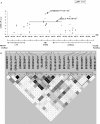Genome-wide association study for femoral neck bone geometry
- PMID: 20175129
- PMCID: PMC3153387
- DOI: 10.1359/jbmr.090726
Genome-wide association study for femoral neck bone geometry
Abstract
Poor femoral neck bone geometry at the femur is an important risk factor for hip fracture. We conducted a genome-wide association study (GWAS) of femoral neck bone geometry, examining approximately 379,000 eligible single-nucleotide polymorphisms (SNPs) in 1000 Caucasians. A common genetic variant, rs7430431 in the receptor transporting protein 3 (RTP3) gene, was identified in strong association with the buckling ratio (BR, P = 1.6 x 10(-7)), an index of bone structural instability, and with femoral cortical thickness (CT, P = 1.9 x 10(-6)). The RTP3 gene is located in 3p21.31, a region that we found to be linked with CT (LOD = 2.19, P = 6.0 x 10(-4)) in 3998 individuals from 434 pedigrees. The replication analyses in 1488 independent Caucasians and 2118 Chinese confirmed the association of rs7430431 to BR and CT (combined P = 7.0 x 10(-3) for BR and P = 1.4 x 10(-2) for CT). In addition, 350 hip fracture patients and 350 healthy control individuals were genotyped to assess the association of the RTP3 gene with the risk of hip fracture. Significant association between a nearby common SNP, rs10514713 of the RTP3 gene, and hip fracture (P = 1.0 x 10(-3)) was found. Our observations suggest that RTP3 may be a novel candidate gene for femoral neck bone geometry.
Copyright 2010 American Society for Bone and Mineral Research.
Figures


Similar articles
-
Bivariate genome-wide association analyses identified genes with pleiotropic effects for femoral neck bone geometry and age at menarche.PLoS One. 2013 Apr 4;8(4):e60362. doi: 10.1371/journal.pone.0060362. Print 2013. PLoS One. 2013. PMID: 23593202 Free PMC article.
-
Association and linkage analysis of COL1A1 and AHSG gene polymorphisms with femoral neck bone geometric parameters in both Caucasian and Chinese nuclear families.Acta Pharmacol Sin. 2007 Mar;28(3):375-81. doi: 10.1111/j.1745-7254.2007.00522.x. Acta Pharmacol Sin. 2007. PMID: 17303000
-
Differences in femoral neck structure between elderly Caucasian and Chinese populations: a cross-sectional study of Perth-Beijing cohorts.Arch Osteoporos. 2017 Aug 15;12(1):72. doi: 10.1007/s11657-017-0366-8. Arch Osteoporos. 2017. PMID: 28812206
-
Mapping quantitative trait loci for cross-sectional geometry at the femoral neck.J Bone Miner Res. 2005 Nov;20(11):1973-82. doi: 10.1359/JBMR.050715. Epub 2005 Jul 18. J Bone Miner Res. 2005. PMID: 16234971
-
Meta-Analysis of Genomewide Association Studies Reveals Genetic Variants for Hip Bone Geometry.J Bone Miner Res. 2019 Jul;34(7):1284-1296. doi: 10.1002/jbmr.3698. Epub 2019 Mar 19. J Bone Miner Res. 2019. PMID: 30888730 Free PMC article.
Cited by
-
Quantitative proteomics and integrative network analysis identified novel genes and pathways related to osteoporosis.J Proteomics. 2016 Jun 16;142:45-52. doi: 10.1016/j.jprot.2016.04.044. Epub 2016 May 3. J Proteomics. 2016. PMID: 27153759 Free PMC article.
-
Bivariate genome-wide association analyses identified genes with pleiotropic effects for femoral neck bone geometry and age at menarche.PLoS One. 2013 Apr 4;8(4):e60362. doi: 10.1371/journal.pone.0060362. Print 2013. PLoS One. 2013. PMID: 23593202 Free PMC article.
-
Quantification of Alterations in Cortical Bone Geometry Using Site Specificity Software in Mouse models of Aging and the Responses to Ovariectomy and Altered Loading.Front Endocrinol (Lausanne). 2015 Apr 23;6:52. doi: 10.3389/fendo.2015.00052. eCollection 2015. Front Endocrinol (Lausanne). 2015. PMID: 25954246 Free PMC article.
-
Genetics of osteoporosis: accelerating pace in gene identification and validation.Hum Genet. 2010 Mar;127(3):249-85. doi: 10.1007/s00439-009-0773-z. Epub 2009 Dec 12. Hum Genet. 2010. PMID: 20101412 Review.
-
Variation in the MC4R gene is associated with bone phenotypes in elderly Swedish women.PLoS One. 2014 Feb 6;9(2):e88565. doi: 10.1371/journal.pone.0088565. eCollection 2014. PLoS One. 2014. PMID: 24516669 Free PMC article.
References
-
- Melton LJ., III Adverse outcomes of osteoporotic fractures in the general population. J Bone Miner Res. 2003;18:1139–1141. - PubMed
-
- Cummings SR, Melton LJ. Epidemiology and outcomes of osteoporotic fractures. Lancet. 2002;359:1761–1767. - PubMed
-
- Cauley JA, Thompson DE, Ensrud KC, Scott JC, Black D. Risk of mortality following clinical fractures. Osteoporos Int. 2000;11:556–561. - PubMed
-
- Cooper C, Campion G, Melton LJ., III. Hip fractures in the elderly: a worldwide projection. Osteoporos Int. 1992;2:285–289. - PubMed
-
- Fleurence RL, Iglesias CP, Torgerson DJ. Economic evaluations of interventions for the prevention and treatment of osteoporosis: a structured review of the literature. Osteoporos Int. 2006;17:29–40. - PubMed
Publication types
MeSH terms
Substances
Grants and funding
LinkOut - more resources
Full Text Sources
Medical

